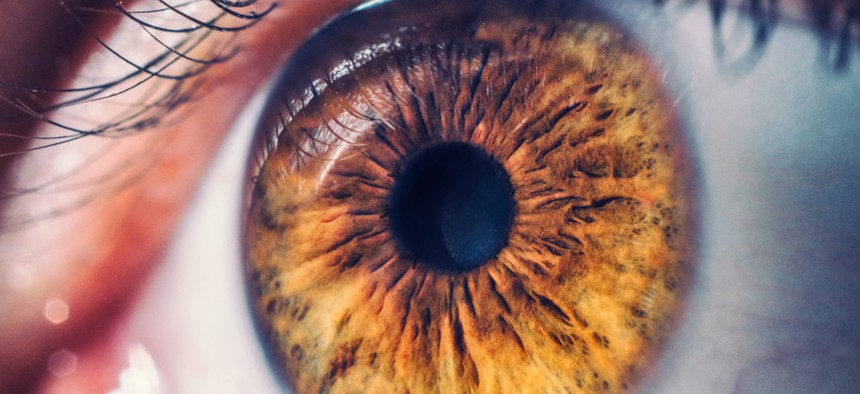
Shutterstock.com
Customs And Border Protection Is Using Retinal Scans To Try To Catch Liars
They may hold promise as deception-detectors, but some think the technology isn't quite there yet.
Customs and Border Protection (CBP) is using a futuristic eye-scanning device to weed out dishonest potential recruits during the initial application phase.
That’s according to a detail contained within a blistering report from the Department of Homeland Security’s Office of the Inspector General (OIG) released last week. The report criticizes the agency for wasting millions of taxpayer dollars on what has so far been an unsuccessful attempt to fulfill president Donald Trump’s January 2017 executive order to hire 7,500 new CBP officers and Border Patrol agents over the next five years.
The OIG report said Accenture Federal Services, the consulting firm CBP retained to help it meet the increased staffing numbers, has not delivered on the “promised hiring process or results.” Only two new CBP employees were hired as of October 1, 10 months into the five-year contract. The company has so far received $13.6 million of a potential $297 million; $43 million has been obligated to Accenture by CBP as of late November.
According to the report, Accenture deployed a Mark Cuban-backed product called EyeDetect, a “retinal scanning tool used to discern deception based on eye and face muscle movement” to pre-screen candidates at a hiring expo in August. But the company did not first get the necessary permissions from the Department of Homeland Security’s Science and Technology Directorate Compliance Assurance Program Manager, which, according to the report, meant the technology shouldn’t have been deployed yet.
DHS refutes this allegation in a section of the report, insisting it did in fact get proper permission to use EyeDetect at the job fair; OIG inspectors say they have “documented evidence that CBP did not.”
Eye-scanners that detect deception in a potential recruit appear to hold tremendous promise, and are faster, and cheaper, than traditional polygraph tests. With CBP under the gun to hire quickly and efficiently, these are obviously attractive features. But while the systems have champions—Cuban himself has been vocal about the potential of EyeDetect—they also have detractors.
One of them is James Tomsheck, a former assistant commissioner in CBP’s internal affairs unit. Tomsheck, who left the agency in 2014, spent the 23 years prior to taking the job at CBP as a special agent with the Secret Service, where his duties included helping develop the accepted polygraph protocols used to screen that agency’s applicants. Using a system like EyeDetect, which is made by a Utah-based company called Converus, could exacerbate the already serious integrity problem among the ranks at CBP, Tomsheck told Quartz.
Neither EyeDetect nor similar types of technologies has ever before been approved by the government’s Office of Personnel Management for the screening of federal applicants, said Tomsheck.
Converus says EyeDetect has an 86% accuracy rate, compared to the 65%-75% accuracy of traditional polygraph tests. However, in 2013, the National Security Agency tested an early version of EyeDetect, which at times performed no better than identifying untruths by random chance. And according to Wired, an upcoming academic chapter written by the co-creator of EyeDetect concedes that the system’s accuracy still can be as low as 50% in certain simulations that don’t replicate the proper conditions.
“My kindest take is that there is some promise, and that perhaps with future independent research this test might provide one measure among many for formulating a hypothesis about deceptive behavior,” psychology professor John Allen told Wired. “But even that would not be definitive evidence.”
In a rebuttal shared with Quartz, Converus said: “Notwithstanding our concern that the WIRED article questions our integrity and transparency, we agree with Dr. Allen that the work should be replicated in other labs by independent investigators. For more than a decade, we have sought independent replication by federal agencies that use deception detection technologies or are tasked with vetting new deception detection technologies. Only recently, and under pressure from Congress, has the government agreed to conduct an independent evaluation of EyeDetect. Unfortunately, they have indicated that their research will not being until January of 2019, and it will take 18 months.”
Tomsheck said there’s no substitute for a full background investigation and a properly administered polygraph. Yet, CBP is currently using a modified polygraph protocol not designed for screening law enforcement recruits. Of course, polygraphs can be problematic for their own reasons. Private companies were barred from using polygraph tests on employees in 1988, and polygraph results are inadmissible in court in most U.S. states.
In the OIG report, CBP management said it disagreed with the overall picture the inspector general’s office painted of Accenture’s supposed lackluster performance. Although it admits the consulting firm has only helped hire two new employees so far, it says Accenture has actually “created a hiring structure, tailored technology solutions to support and manage the hiring process, stood up an applicant care center, marketed and recruited thousands of new applicants, and conducted many of the hiring steps for several thousand applicants.”
“CBP is constantly working to strengthen its hiring capabilities to ensure staffing for critical frontline operations, while maintaining our high personnel standards,” a CBP spokesperson told Quartz in an email. “While we take some exception to the OIG’s characterization of the contract, we do agree the contract has been a challenge, primarily due to the innovative efforts by both parties, and we are reviewing how best to use it moving forward.”






